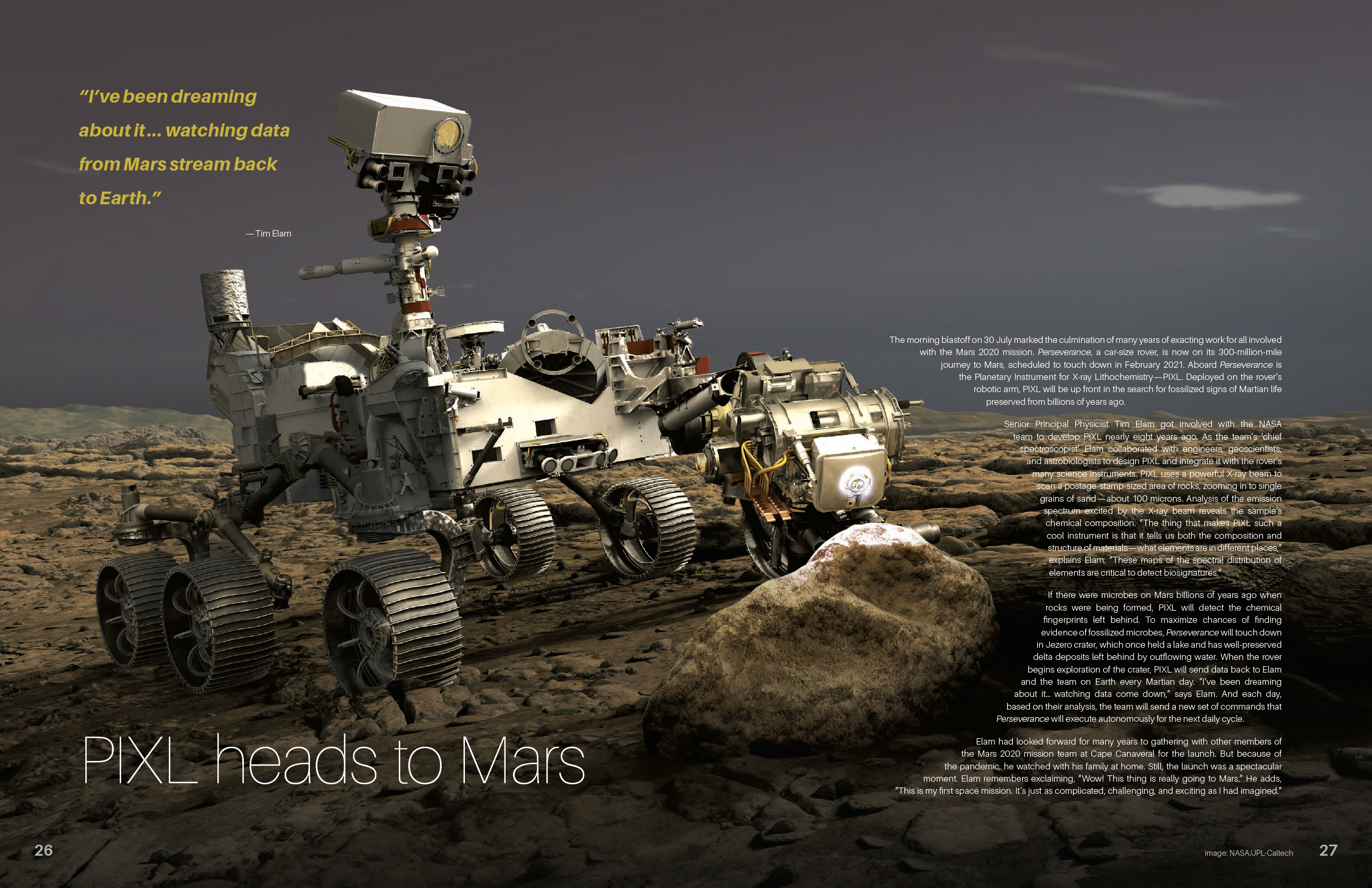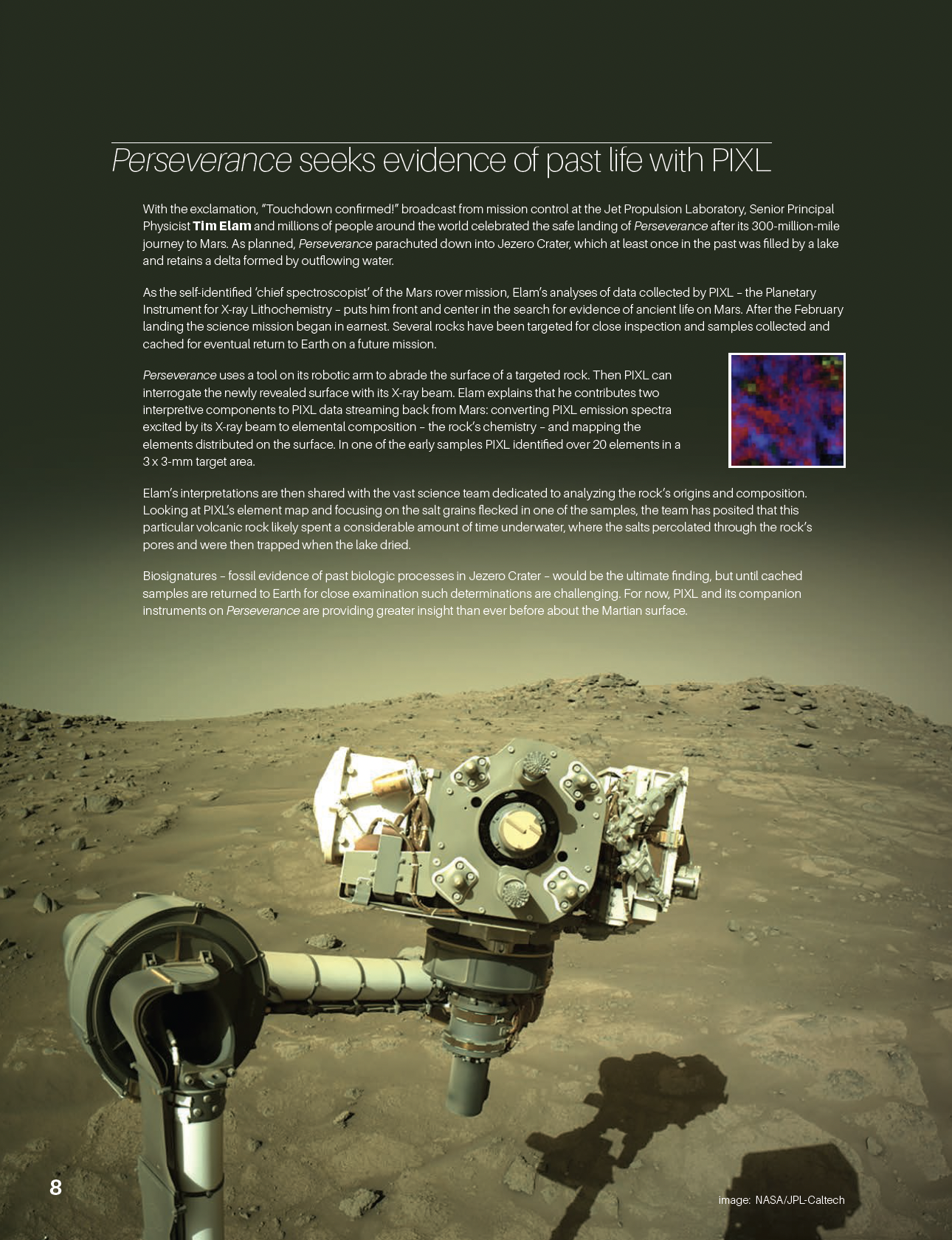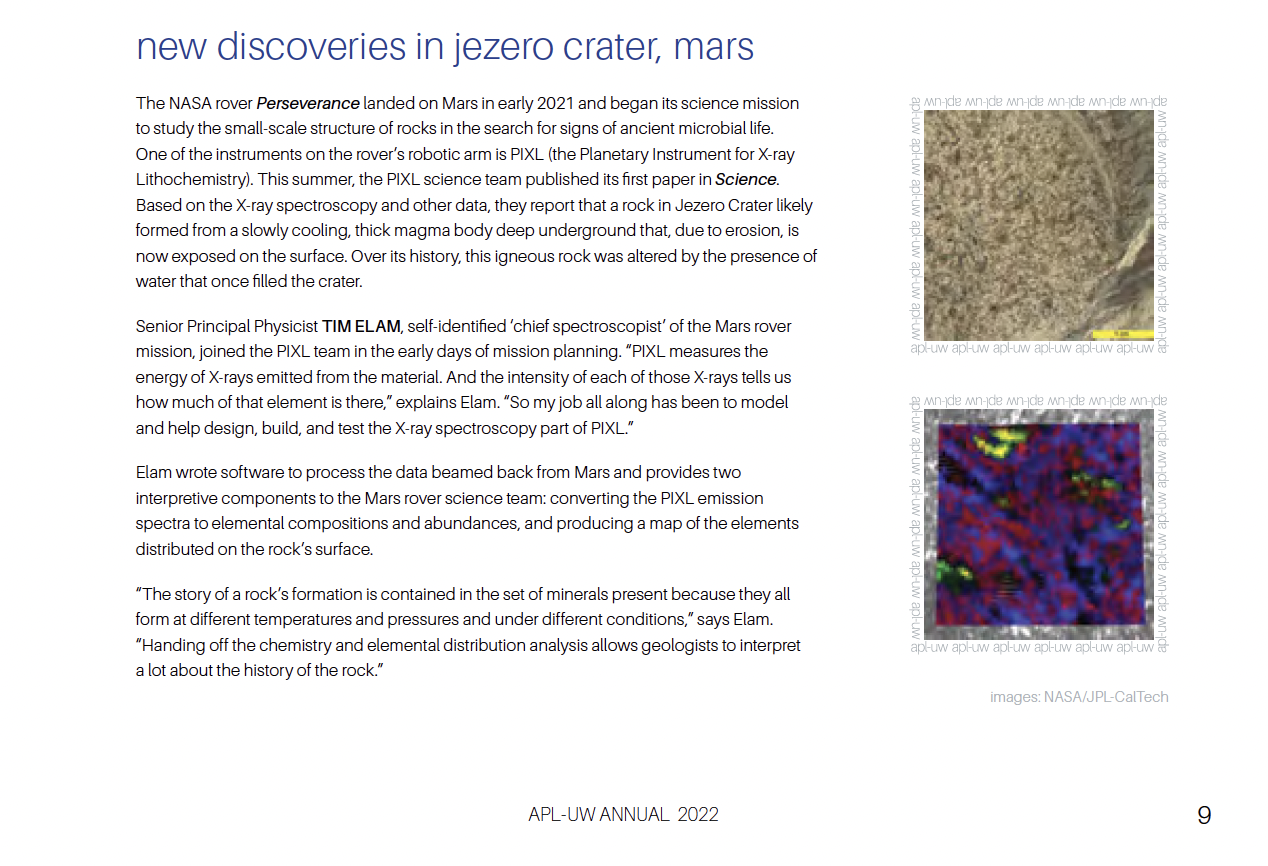|
|
PIXL — Planetary Instrument for X-ray Lithochemistry
on the Mars Rover Perseverance
|
Robot Geologist Finds the Most Fascinating Rock Yet
|
|
|
NASA reported 25 July 2024 that the rover Perseverance found a rock on the surface of Mars that "… exhibits chemical signatures and structures that could possibly have been formed by life billions of years ago when the area being explored by the rover contained running water." After a successful landing on Mars in February 2021, Perseverance has searched in a long-dry lake bed for signs of ancient microbial life.
Project scientists say they've discovered something never seen before on Mars. Ken Farley, at Caltech in Pasadena, said, "We have our first compelling detection of organic material, distinctive colorful spots indicative of chemical reactions that microbial life could use as an energy source, and clear evidence that water once passed through the rock."
"As soon as I saw the first image that was beamed back to Earth, I recognized the 'leopard spots'," remarks Tim Elam, who has served as the 'chief spectroscopist' for the mission and been involved from the beginning in the design, operation, and analysis of data from PIXL. "Scientists posit that similar spherical structures are associated with bacterial life on the early Earth."
PIXL's X-ray beam scans the surface of rock samples. The emission spectrum excited by the beam reveals the rock's elemental composition as well as its structure — how the elements are distributed and arranged on the surface.
|
NASA’s Perseverance Rover Scientists Find Intriguing Mars Rock (25 July)
NASA/JPL Press Release |
|
 |
|
|

NASA
On the rock they've named Cheyava Falls are dozens of irregularly shaped, millimeter-size, off-white spots, each ringed with black halos that contain both iron and phosphate. "Never before PIXL could scientists measure on Mars the arrangement of elements on samples, which is crucial to finding biosignatures," adds Elam.
This is a 'dream come true' for Elam and the entire mission team, but they are proceeding with caution. These spots are potential biosignatures, but to draw further conclusions, samples from Cheyava Falls and other rocks collected by Perseverance will have to be brought back to Earth to be studied with powerful instruments available only in laboratories.
|
|
PIXL in APL-UW Annual Reports
|
|
PIXL Videos
|
|
PIXL heads to Mars (PDF, 927 KB)
|
|
 |
|
Perseverance seeks evidence of past life with PIXL (PDF, 470 KB)
|
|
 |
|
New discoveries in Jezero Crater, Mars (PDF, 148 KB)
|
|
 |
|
|
First Analysis of Martian Rocks Based on PIXL Data Published in Science
PIXL on the Mars 2020 Mission
|
|
PIXL Publications
|
 |
|
A statistical approach to removing diffraction from X-ray fluorescence spectra Orenstein, B.J., D.T. Flannery, L.W. Casey, W.T. Elam, C.M. Heirwegh, M.W.M. Jones, "A statistical approach to removing diffraction from X-ray fluorescence spectra," Spectrochim. Acta, Part B, 200, doi:10.1016/j.sab.2022.106603, 2023. |
|
More Info
| |
|
1 Feb 2023 
|
|
 |
|
|
Diffraction peaks can lead to inaccurate elemental abundances in X-ray fluorescence maps. However, manually removing diffraction peaks is laborious while existing automated methods unnecessarily remove significant volumes of fluorescence data. Here we propose a new automated method to remove diffraction from multiple-detector spectra based on a statistical threshold. This method eliminates only the diffraction peaks from the spectra, retaining more of the fluorescence data and increasing the information content available for diffraction-free elemental quantification and mapping. By retaining the majority of the fluorescence data, the proposed method does not require an increase in dwell times or additional data to be collected to compensate for the removed fluorescence data. This method is therefore particularly valuable in instances where measurement time and data volumes are highly restricted, such as for instruments on planetary exploration missions like the Planetary Instrument for X-ray Lithochemistry on NASA's Mars 2020 mission Perseverance Rover.
|
|
 |
|
The focused beam X-ray fluorescence elemental quantification software package PIQUANT Heirwegh, C.M., W.T. Elam, L.P. O'Neil, K.P. Sinclair, and A. Das, "The focused beam X-ray fluorescence elemental quantification software package PIQUANT," Spectrochim. Acta, Part B, 196, doi:10.1016/j.sab.2022.106520, 2022. |
|
More Info
| |
|
1 Oct 2022 
|
|
 |
|
|
Adoption of a robust X-ray fluorescence spectroscopy quantification and spectrum fitting routine calls for careful consideration on the inner workings and databases incorporated in its architecture. For analysis of micro-XRF data returned from the Planetary Instrument for X-ray Lithochemistry (PIXL), integrated on the Mars 2020 Perseverance rover, the University of Washington and the National Aeronautics and Space Administration (NASA) have invested in the production of an in-house micro-XRF software package, PIQUANT, capable of supporting quantitative elemental analysis of whole rock and geological materials. The PIQUANT software uses an iterative fundamental parameters physics-based model to convert X-ray peak intensity into elemental concentration, and has minimal reliance on calibration using standards. It also incorporates polycapillary optic transmission correction to account for photon passage in the X-ray optic of micro-XRF systems. This work introduces the key features of PIQUANT's architecture, its databases, models, assumptions and summarizes features available as part of the analysis products it generates. A working example of a quantification process available with this software is presented within.
|
|
 |
|
An olivine cumulate outcrop on the floor of Jezero crater, Mars Liu, Y., and 71 others including W.T. Elam and K. Sinclair, "An olivine cumulate outcrop on the floor of Jezero crater, Mars," Science, 377, 1513-1519, doi:10.1126/science.abo2756, 2022. |
|
More Info
| |
|
25 Aug 2022 
|
|
 |
|
|
The geological units on the floor of Jezero crater, Mars, are part of a wider regional stratigraphy of olivine-rich rocks, which extends well beyond the crater. We investigate the petrology of olivine and carbonate-bearing rocks of the Séítah formation in the floor of Jezero. Using multispectral images and x-ray fluorescence data, acquired by the Perseverance rover, we performed a petrographic analysis of the Bastide and Brac outcrops within this unit. We find that these outcrops are composed of igneous rock, moderately altered by aqueous fluid. The igneous rocks are mainly made of coarse-grained olivine, similar to some Martian meteorites. We interpret them as an olivine cumulate, formed by settling and enrichment of olivine through multi-stage cooling of a thick magma body.
|
|
 |
|
Optimized Compton fitting and modeling for light element determination in micro-X-ray fluorescence map datasets O'Neil, L.P., D.C. Catling, and W.T. Elam, "Optimized Compton fitting and modeling for light element determination in micro-X-ray fluorescence map datasets," Nucl. Instrum. Methods Phys. Res., Sect. B, 436, 173-178, doi:10.1016/j.nimb.2018.09.023, 2018. |
|
More Info
| |
|
1 Dec 2018 
|
|
 |
|
|
The Planetary Instrument for X-ray Lithochemistry (PIXL) is an X-ray fluorescence instrument scheduled to fly to Mars on NASA's 2020 rover (Allwood et al., 2015). It will be capable of quantifying elements with atomic number of at least 11 using X-ray fluorescence (XRF), but the detector window blocks fluorescence from lighter elements. Important elements otherwise invisible include carbon, oxygen, and nitrogen, which can make up anions in minerals of scientific interest. X-rays scattered by all elements can be detected, so the ratio of Compton to Rayleigh scatter may be measured and used to infer the presence of elements for which there is no detectable fluorescence. We have refined a fundamental parameters model to predict the Compton/Rayleigh ratio for any given composition that can be compared to an experimentally measured ratio. We compare with a published Monte Carlo model (Schoonjans et al., 2012) and to experimental values for a set of seven materials. Compton/Rayleigh ratios predicted by the model are in good, though imperfect, agreement with experimental measurements. A procedure for consistently computing the Compton/Rayleigh ratio from a noisy spectrum has also been developed using a variation on a common background removal method and peak fitting.
|
|
 |
|
An empirical derivation of the X-ray optic transmission profile used in calibrating the Planetary Instrument for X-ray Lithochemistry (PIXL) for Mars 2020 Heirwegh, C.M., W.T. Elam, D.T. Flannery, and A.C. Allwood, "An empirical derivation of the X-ray optic transmission profile used in calibrating the Planetary Instrument for X-ray Lithochemistry (PIXL) for Mars 2020," Powder Diffr., 33, 162-165, doi:10.1017/S0885715618000416, 2018. |
|
More Info
| |
|
1 Jun 2018 
|
|
 |
|
|
Calibration of the prototype Planetary Instrument for X-ray Lithochemistry (PIXL) selected for Mars 2020 has commenced with an empirical derivation of the X-ray optic transmission profile. Through a straightforward method of dividing a measured "blank" spectrum over one calculated assuming no optic influence, a rudimentary profile was formed. A simple boxcar-smoothing algorithm was implemented to approximate the complete profile that was incorporated into PIQUANT. Use of this form of smoothing differs from the more conventional approach of using a parameter-based function to complete the profile. Comparison of element-specific correction factors, taken from a measurement of NIST SRM 610, was used to assess the accuracy of the new profile. Improvement in the low- to mid-energy portion of the data was apparent though the high-energy region diverged from unity, and thus, requires further refinement.
|
|
|
|









